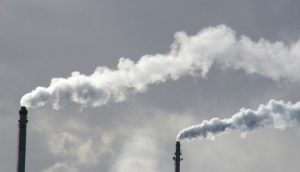China and India have been reducing their carbon intensity per unit of production for over a decade, but this move towards green growth “appears to have stalled” in 2011, according to a
new report by PriceWaterhouseCoopers (PwC). Current rates of decarbonisation point to a six-degree global temperature rise, warns the consulting firm.
The analysis in the
PwC Low Carbon Economy Index, measuring developed and emerging economies progress towards reducing emissions linked to economic output, demonstrates that at current rates of emissions growth at least 6 degrees Celsius of warming could be possible by the end of the century.
PwC says that in both China and India strong GDP growth was closely coupled with rapid emissions growth last year, despite commitments to the international community to significantly reduce carbon intensity by 2020: 40-45% for China and 20-25% for India respectively, relative to 2005 levels.
Read: China losing 1.4% of GDP to climate change and reliance on carbon
The challenge to decouple emissions from economic growth is not easy for these emerging economies. The report points out that China and India are expected to nearly double the size of their economies by the end of the decade, but emissions must level off soon for them to meet their targets. This means the majority of any new energy demand will have to be met from renewable energy and not fossil fuel generation (unless this can be fitted with carbon capture and storage).
Talking about the other BRIC countries, the report adds that Russia and Brazil expect slower economic growth, but their emissions pledges imply a more drastic cut in carbon intensity than both China and India. Brazil, of course, has great scope to reduce emissions by reducing deforestation, an aspect that has not been taken into account in the PWC study.
Emissions of greenhouse gases, mainly carbon dioxide, are causing global warming, which in turn is affecting agriculture worldwide, and making droughts, floods and storms more severe and more frequent, according to scientists at the
Intergovernmental Panel on Climate Change. Power generation through coal and oil is the biggest source of carbon emissions.
Compared to China’s commitment to reduce carbon intensity per unit of production by 40-45% by 2020 compared to 2005, in 2011 this figure stood at 17% below, says the report. In India, it was only 3% below, compared to the promise of a 20-25% reduction. This means that to meet its commitment, China will now require an emissions change of 12% by 2020, which translates to an annual decarbonisation rate of 4.5% for the rest of this decade. India will need an emissions change of 31%, which means a 2.8% annual decarbonisation rate till 2020. China is now the world’s largest greenhouse gas emitter, followed by the US and India.
Of the other BRIC countries, Russia has a commitment of reducing its emissions by 15-25% below 1990 levels, but its emissions in 2011 were only 5% below, says the report. It goes on to add that Russia will now require an emissions reduction of 19% by 2020, which translates to an annual decarbonisation rate of 5.8%. Brazil had committed to reduce its emissions by 36-39% below business as usual levels. Its progress in 2011 against that pledge was not available, but PWC calculates it will need an emissions reduction of 25% by 2020 to meet the pledge, which means an annual decarbonisation rate of 6.8%, not counting what it can do by reducing deforestation.
Major developed economies have done just as badly. The US has pledged that by 2020, it will reduce its emissions by 17% compared to 2005, but the progress so far is only 7%. To meet the pledge, the world’s biggest economy will have to replace all its coal-fired power generation by gas, PWC calculates. The 15 biggest countries of the European Union had pledged to cut their emissions by 20% from 1990 levels, but have cut only 5.5% by now, says the report. It adds that to meet the pledge, Britain will have to remove all its current emissions. Japan had promised to reduce emissions by 25% from 1990 levels, and is now at 12%. The report says it will have to remove all emissions from its industrial sector to meet the pledge.
The Low Carbon Economy Index league table below shows all G20 countries and the required annual decarbonisation rate needed between 2012 and 2050.
|
Country
|
Change in energy emissions 2010-2011
|
GDP growth 2010-2011
|
|
Change in carbon intensity 2010-2011
|
Annual average change 2000-2011
|
Required annual decarbonisation rate 2012-2050
|
|
France
|
-6.1%
|
1.7%
|
|
-7.7%
|
-2.4%
|
-4.4%
|
|
UK
|
-6.4%
|
0.7%
|
|
-7.0%
|
-2.8%
|
-5.2%
|
|
Germany
|
-3.6%
|
3%
|
|
-6.4%
|
-2.2%
|
-5.2%
|
|
Indonesia
|
0.9%
|
6.5%
|
|
-5.2%
|
-1.0%
|
-4.9%
|
|
EU
|
-3.6%
|
1.5%
|
|
-5.1%
|
-2.3%
|
-5.2%
|
|
USA
|
-1.9%
|
1.7%
|
|
-3.5%
|
-2.1%
|
-5.2%
|
|
Italy
|
-2.5%
|
0.4%
|
|
-2.9%
|
-1.2%
|
-4.3%
|
|
Mexico
|
1.7%
|
3.9%
|
|
-2.1%
|
-0.2%
|
-4.6%
|
|
South Africa
|
1.5%
|
3.1%
|
|
-1.6%
|
-1.4%
|
-5.6%
|
|
Russia
|
2.9%
|
4.3%
|
|
-1.6%
|
-3.9%
|
-6.0%
|
|
Brazil
|
1.7%
|
2.7%
|
|
-1.0%
|
-0.7%
|
-4.1%
|
|
Argentina
|
7.9%
|
8.9%
|
|
-0.9%
|
-1.6%
|
-5.0%
|
|
South Korea
|
2.9%
|
3.6%
|
|
-0.7%
|
-1.0%
|
-6.5%
|
|
Canada
|
2.0%
|
2.5%
|
|
-0.4%
|
-1.4%
|
-5.3%
|
|
Saudi Arabia
|
6.7%
|
6.8%
|
|
0.0%
|
-1.9%
|
-7.0%
|
|
India
|
6.9%
|
6.9%
|
|
0.0%
|
-1.4%
|
-4.4%
|
|
Turkey
|
8.6%
|
8.5%
|
|
0.1%
|
-0.5%
|
-5.0%
|
|
China
|
9.4%
|
9.1%
|
|
0.2%
|
-1.4%
|
-6.1%
|
|
Japan
|
0.1%
|
-0.7%
|
|
0.8%
|
-0.8%
|
-4.8%
|
|
Spain
|
2.2%
|
0.7%
|
|
1.5%
|
-1.9%
|
-3.6%
|
|
Australia
|
8.7%
|
1.8%
|
|
6.7%
|
-1.7%
|
-5.3%
|
|
World
|
3.0%
|
3.7%
|
|
-0.7%
|
-0.8%
|
-5.1%
|
Source: PwC’s analysis, data from World Bank (2012) and BP Statistical Review (2012)
Scientists have been warning that a global temperature rise of over 2 degrees Celsius will have unforeseen and potentially catastrophic effects. All governments have agreed to keep the rise within 2 degrees, but their collective commitments fall short of that goal by as much as 40%. The report says, “Even more worryingly, with eight years to go, it is questionable whether several of these pledges can be met.” It adds, “In some respects the economic downturn may make these absolute pledges less challenging; but at the same time economic pressures may make it much harder to finance the necessary transition towards a low carbon economy.”
Analysing the report, PwC also pointed out, “The rate of reduction now required has never been achieved before.”
With less than three weeks to the next summit of the
UN climate summit, the analysis illustrates the scale of the challenge facing negotiations, PwC points out.





